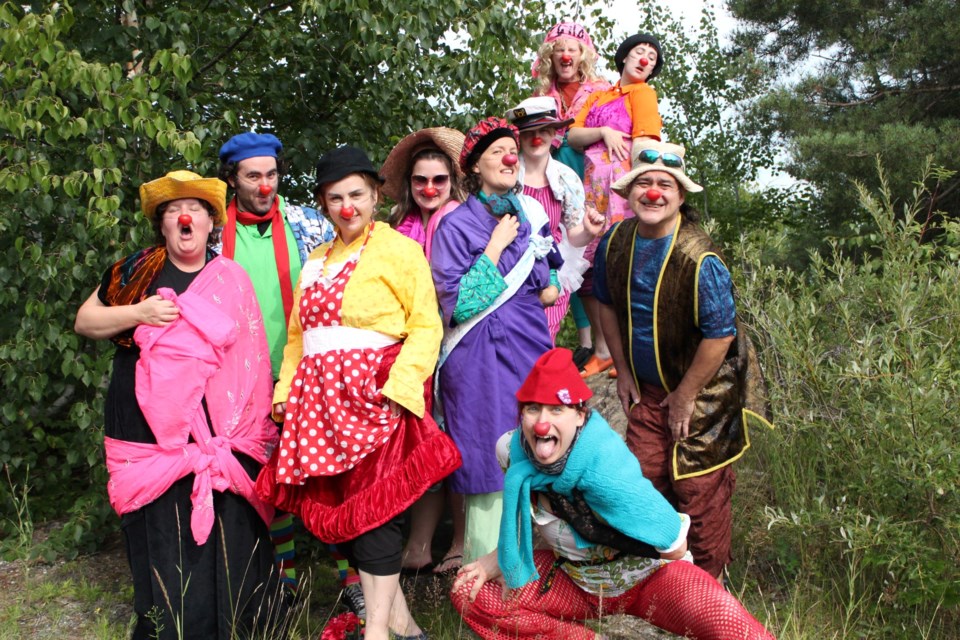Twenty new clowns were “born” in Sudbury this month, including Johanna Arnott, a theatre artist based out of Saskatoon, Sask.
She is one of the students at clowning workshops put on by One North Clown and Creation, an initiative by Sudburian Jenny Hazelton, formerly a professor in Thorneloe University’s now-defunct theatre program.
Arnott, who has always wanted to attend clown school, finally received a government grant to get the training. She said the lessons she’s learned in Sudbury will be invaluable to her theatre career, in which she often performs for young audiences.
The theatre artist has always been a very analytical person, but the clowning workshop has encouraged her to be more in touch with her emotions as she performs, something she said is “really freeing and exciting.”
While clowning isn’t so scripted as most theatre pieces, Arnott can see how she can adapt the lessons she’s learned to her own non-clowning career.
“If you're given the scripts, you have to follow the scripts,” she said. “But I think there's ways that the tools that I've learned here can assist me in understanding character, specifically the movement and voice of different characters and their wants in the story.”
For most of the summer, One North Clown and Creation is running courses out of Thorneloe University, the formerly federated university located on Laurentian University’s campus.
First up was the two-week-long Mask and Clown Intensive (also known as Baby Clown), in which students get their feet wet in the world of clowning.
This is followed by the week-long Clown Boot Camp, for those coming out of Baby Clown or who wish to reacquaint themselves with the foundation of this style.
Both of these workshops were led by instructor John Turner, who ran his own clowning school out of Manitoulin Island for years. (Turner, by the way, is the “Smoot” half of the award-winning Canadian clown duo Mump and Smoot).
As previously mentioned, 20 students attended the Baby Clown workshop earlier in July, in which they’re “born” into the world as new clowns, while 16 attended Clown Boot Camp, which was just held this past week.
August will see workshops on the “neo-Bouffan” style (a performance work focused on the art of mockery) and on new work development, both run by instructor Karen Hines.
Turner and Hazelton met years ago when Hazelton took the Baby Clown workshop at Turner’s Clown Farm, which he operated on Manitoulin Island for 19 years.
Then before the pandemic, Turner closed the Clown Farm — a program in which Hazelton previously assisted — and he and his wife packed up and moved to Cape Breton.
Wanting to keep the program alive, in 2022 Hazelton brought it to Sudbury, at Thorneloe University, which has both a residence that’s underused in the summertime (perfect for out-of-town students) and a theatre from the university’s former theatre program.
The workshops are attended by students from around the world, and, although many theatre professionals attend them as a way of improving their craft, people from all walks of life also take part.
They’ve had rabbis and priests, teachers, engineers and scientists enrol in the course. “Sometimes people are just looking to shake things up and right, stretch creatively and don't intend to become clowns or anything like that, they're just looking for something different,” said Hazelton, One Clown’s artistic director.
“It's creativity training at the initial levels, right?” said Turner. “It's all work on imagination and creativity and coming up with fantastical stuff, characters, etc. It’s a boost for anybody in any form of arts. We get a lot of teachers. So anybody that's up in front of people. A lot of it is about having open conversations.”
Asked why actors would need to learn clowning in this day and age, Turner said it’s a way for them to stretch their creative muscles, and move “further in different directions, deeper and further into character work.”
Clowning, said Turner, is not as popular as it would have been 100 years ago, but he said he’s seen it gain popularity over the past three decades.
He also sees clowning at the roots of performances by popular actors such as Jim Carrey or Rowan Atkinson (a.k.a. “Mr. Bean”), as well as the comedy groups Wayne and Shuster and Monty Python.
The art form has been around “since the dawn of time,” he said. And it’s not just about entertaining kids at birthday parties, it’s something for adults too.
“Every culture has a form of clowning,” Turner said. “Usually it's in place to offer a skewed mirror on society. A lot of the time you hear things it speaks truth to power. So they make fun of the big wigs and the muckety-mucks to remind them that they're human beings and then they have someone to answer to.”
While some people even see clowns as “scary” (remember the creepy clown trend of 2016?), Hazelton said clowning has allowed her to see the goodness in herself and others.
“It perhaps made me a more open-hearted person,” she said. “In doing this work with other people, you see their hearts. It’s sort of reestablished my faith in humanity in a way because we see the goodness in people, the light.”
Heidi Ulrichsen is Sudbury.com’s associate content editor. She also covers education and the arts scene.
